聚碳硅烷对注射成形Fe-2Ni基复合材料显微组织和力学性能的影响
聚硅氧烷封孔处理对C-sub-f-sub-SiC复合材料抗氧化性能的影响
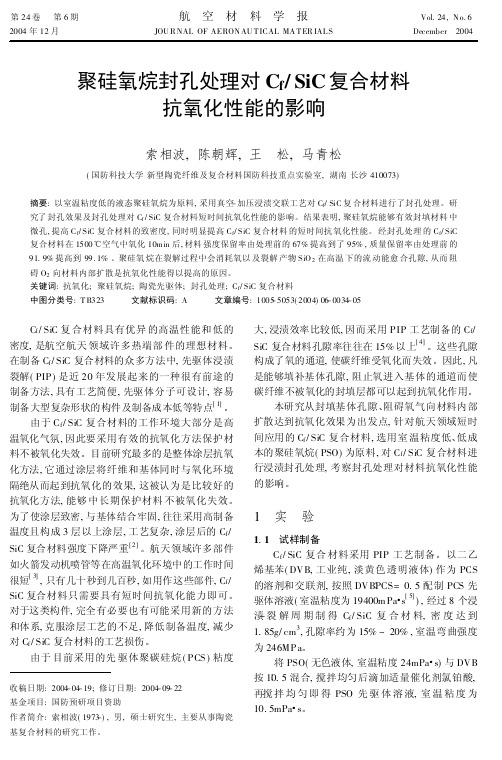
聚硅氧烷封孔处理对C f/SiC复合材料抗氧化性能的影响索相波,陈朝辉,王 松,马青松(国防科技大学新型陶瓷纤维及复合材料国防科技重点实验室,湖南长沙410073)摘要:以室温粘度低的液态聚硅氧烷为原料,采用真空-加压浸渍交联工艺对C f/SiC复合材料进行了封孔处理。
研究了封孔效果及封孔处理对C f/SiC复合材料短时间抗氧化性能的影响。
结果表明,聚硅氧烷能够有效封填材料中微孔,提高C f/SiC复合材料的致密度,同时明显提高C f/SiC复合材料的短时间抗氧化性能。
经封孔处理的C f/SiC 复合材料在1500 空气中氧化10min后,材料强度保留率由处理前的67%提高到了95%,质量保留率由处理前的91.9%提高到99.1%。
聚硅氧烷在裂解过程中会消耗氧以及裂解产物SiO2在高温下的流动能愈合孔隙,从而阻碍O2向材料内部扩散是抗氧化性能得以提高的原因。
关键词:抗氧化;聚硅氧烷;陶瓷先驱体;封孔处理;C f/SiC复合材料中图分类号:T B323 文献标识码:A 文章编号:1005-5053(2004)06-0034-05C f/SiC复合材料具有优异的高温性能和低的密度,是航空航天领域许多热端部件的理想材料。
在制备C f/SiC复合材料的众多方法中,先驱体浸渍裂解(PIP)是近20年发展起来的一种很有前途的制备方法,具有工艺简便,先驱体分子可设计,容易制备大型复杂形状的构件及制备成本低等特点[1]。
由于C f/SiC复合材料的工作环境大部分是高温氧化气氛,因此要采用有效的抗氧化方法保护材料不被氧化失效。
目前研究最多的是整体涂层抗氧化方法,它通过涂层将纤维和基体同时与氧化环境隔绝从而起到抗氧化的效果,这被认为是比较好的抗氧化方法,能够中长期保护材料不被氧化失效。
为了使涂层致密,与基体结合牢固,往往采用高制备温度且构成3层以上涂层,工艺复杂,涂层后的C f/ SiC复合材料强度下降严重[2]。
聚碳硅烷和二乙烯基苯的交联及纳米SiC陶瓷的制备
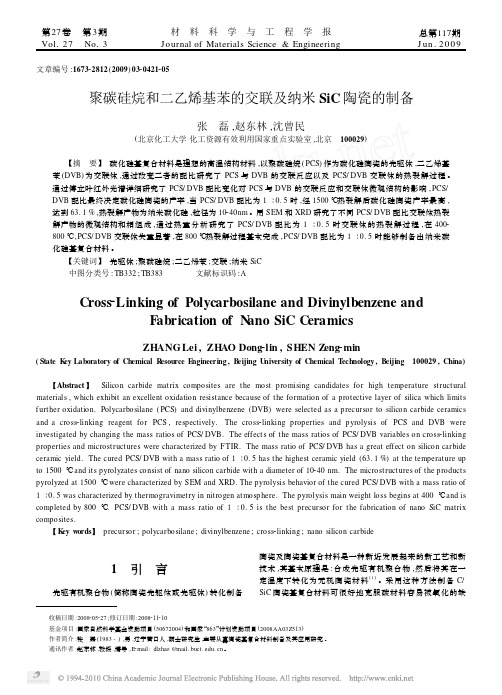
第27卷 第3期Vol 127 No 13材 料 科 学 与 工 程 学 报Journal of Materials Science &Engineering 总第117期J un.2009文章编号:167322812(2009)0320421205聚碳硅烷和二乙烯基苯的交联及纳米SiC 陶瓷的制备张 磊,赵东林,沈曾民(北京化工大学化工资源有效利用国家重点实验室,北京 100029) 【摘 要】 碳化硅基复合材料是理想的高温结构材料,以聚碳硅烷(PCS )作为碳化硅陶瓷的先驱体,二乙烯基苯(DVB )为交联体,通过改变二者的配比研究了PCS 与DVB 的交联反应以及PCS/DVB 交联体的热裂解过程。
通过傅立叶红外光谱详细研究了PCS/DVB 配比变化对PCS 与DVB 的交联反应和交联体微观结构的影响,PCS/DVB 配比最终决定碳化硅陶瓷的产率,当PCS/DVB 配比为1∶0.5时,经1500℃热裂解后碳化硅陶瓷产率最高,达到63.1%,热裂解产物为纳米碳化硅,粒径为10240nm 。
用SEM 和XRD 研究了不同PCS/DVB 配比交联体热裂解产物的微观结构和相组成,通过热重分析研究了PCS/DVB 配比为1∶0.5时交联体的热裂解过程,在4002800℃,PCS/DVB 交联体失重显著,在800℃热裂解过程基本完成,PCS/DVB 配比为1∶0.5时能够制备出纳米碳化硅基复合材料。
【关键词】 先驱体;聚碳硅烷;二乙烯苯;交联;纳米SiC 中图分类号:TB332;TB383 文献标识码:ACross 2Linking of Polycarbosilane and Divinylbenzene andF abrication of N ano SiC CeramicsZHANG Lei ,ZHAO Dong 2lin ,SHEN Z eng 2min(State K ey Laboratory of Chemical R esource E ngineering ,B eijing U niversity of Chemical T echnology ,B eijing 100029,China)【Abstract 】 Silicon carbide matrix composites are the most promising candidates for high temperature structural materials ,which exhibit an excellent oxidation resistance because of the formation of a protective layer of silica which limits f urther oxidation.Polycarbosilane (PCS )and divinylbenzene (DVB )were selected as a precursor to silicon carbide ceramics and a cross 2linking reagent for PCS ,respectively.The cross 2linking properties and pyrolysis of PCS and DVB were investigated by changing the mass ratios of PCS/DVB.The effects of the mass ratios of PCS/DVB variables on cross 2linking properties and microstructures were characterized by FTIR.The mass ratio of PCS/DVB has a great effect on silicon carbide ceramic yield.The cured PCS/DVB with a mass ratio of 1∶0.5has the highest ceramic yield (63.1%)at the temperature upto 1500℃and its pyrolyzates consist of nano silicon carbide with a diameter of 10240nm.The microstructures of the products pyrolyzed at 1500℃were characterized by SEM and XRD.The pyrolysis behavior of the cured PCS/DVB with a mass ratio of 1∶0.5was characterized by thermogravimetry in nitrogen atmosphere.The pyrolysis main weight loss begins at 400℃and is completed by 800℃.PCS/DVB with a mass ratio of 1∶0.5is the best precursor for the fabrication of nano SiC matrix composites.【K ey w ords 】 precursor ;polycarbosilane ;divinylbenzene ;cross 2linking ;nano silicon carbide收稿日期:2008205227;修订日期:2008211210基金项目:国家自然科学基金资助项目(50672004)和国家“863”计划资助项目(2008AA03Z513)作者简介:张 磊(1983-),男,辽宁营口人,硕士研究生,主要从事陶瓷基复合材料制备及其应用研究。
添加聚碳硅烷(PCS)对ZrB2-SiC超高温陶瓷微结构和力学性能的影响
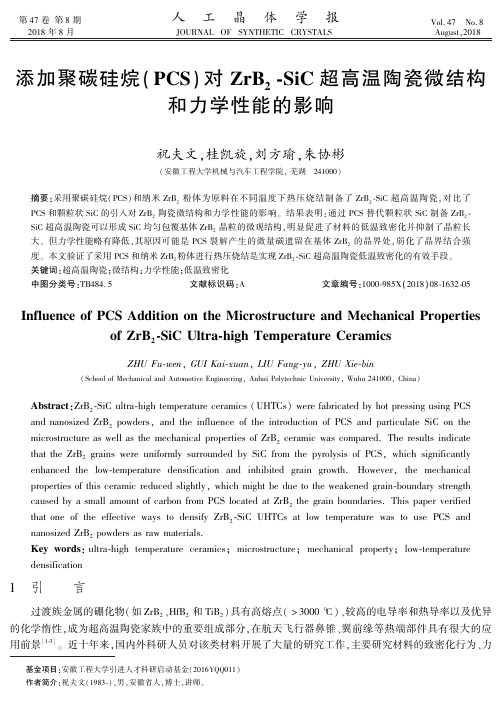
㊀第47卷第8期㊀㊀㊀㊀㊀㊀㊀㊀㊀人㊀工㊀晶㊀体㊀学㊀报㊀㊀㊀㊀㊀㊀㊀Vol.47㊀No.8㊀2018年8月㊀㊀㊀㊀㊀㊀㊀㊀JOURNALOFSYNTHETICCRYSTALS㊀㊀㊀㊀㊀㊀㊀Augustꎬ2018添加聚碳硅烷(PCS)对ZrB2 ̄SiC超高温陶瓷微结构和力学性能的影响祝夫文ꎬ桂凯旋ꎬ刘方瑜ꎬ朱协彬(安徽工程大学机械与汽车工程学院ꎬ芜湖㊀241000)摘要:采用聚碳硅烷(PCS)和纳米ZrB2粉体为原料在不同温度下热压烧结制备了ZrB2 ̄SiC超高温陶瓷ꎬ对比了PCS和颗粒状SiC的引入对ZrB2陶瓷微结构和力学性能的影响ꎮ结果表明:通过PCS替代颗粒状SiC制备ZrB2 ̄SiC超高温陶瓷可以形成SiC均匀包覆基体ZrB2晶粒的微观结构ꎬ明显促进了材料的低温致密化并抑制了晶粒长大ꎮ但力学性能略有降低ꎬ其原因可能是PCS裂解产生的微量碳遗留在基体ZrB2的晶界处ꎬ弱化了晶界结合强度ꎮ本文验证了采用PCS和纳米ZrB2粉体进行热压烧结是实现ZrB2 ̄SiC超高温陶瓷低温致密化的有效手段ꎮ关键词:超高温陶瓷ꎻ微结构ꎻ力学性能ꎻ低温致密化中图分类号:TB484.5㊀㊀文献标识码:A㊀㊀文章编号:1000 ̄985X(2018)08 ̄1632 ̄05㊀㊀基金项目:安徽工程大学引进人才科研启动基金(2016YQQ011)㊀㊀作者简介:祝夫文(1983 ̄)ꎬ男ꎬ安徽省人ꎬ博士ꎬ讲师ꎮInfluenceofPCSAdditionontheMicrostructureandMechanicalPropertiesofZrB2 ̄SiCUltra ̄highTemperatureCeramicsZHUFu ̄wenꎬGUIKai ̄xuanꎬLIUFang ̄yuꎬZHUXie ̄bin(SchoolofMechanicalandAutomotiveEngineeringꎬAnhuiPolytechnicUniversityꎬWuhu241000ꎬChina)Abstract:ZrB2 ̄SiCultra ̄hightemperatureceramics(UHTCs)werefabricatedbyhotpressingusingPCSandnanosizedZrB2powdersꎬandtheinfluenceoftheintroductionofPCSandparticulateSiConthemicrostructureaswellasthemechanicalpropertiesofZrB2ceramicwascompared.TheresultsindicatethattheZrB2grainswereuniformlysurroundedbySiCfromthepyrolysisofPCSꎬwhichsignificantlyenhancedthelow ̄temperaturedensificationandinhibitedgraingrowth.Howeverꎬthemechanicalpropertiesofthisceramicreducedslightlyꎬwhichmightbeduetotheweakenedgrain ̄boundarystrengthcausedbyasmallamountofcarbonfromPCSlocatedatZrB2thegrainboundaries.ThispaperverifiedthatoneoftheeffectivewaystodensifyZrB2 ̄SiCUHTCsatlowtemperaturewastousePCSandnanosizedZrB2powdersasrawmaterials.Keywords:ultra ̄hightemperatureceramicsꎻmicrostructureꎻmechanicalpropertyꎻlow ̄temperaturedensification1㊀引㊀㊀言过渡族金属的硼化物(如ZrB2㊁HfB2和TiB2)具有高熔点(>3000ħ)㊁较高的电导率和热导率以及优异的化学惰性ꎬ成为超高温陶瓷家族中的重要组成部分ꎬ在航天飞行器鼻锥㊁翼前缘等热端部件具有很大的应用前景[1 ̄3]ꎮ近十年来ꎬ国内外科研人员对该类材料开展了大量的研究工作ꎬ主要研究材料的致密化行为㊁力第8期祝夫文等:添加聚碳硅烷(PCS)对ZrB2 ̄SiC超高温陶瓷微结构和力学性能的影响1633㊀学性能㊁抗热冲击性能和抗氧化烧蚀性能[4 ̄7]ꎮZrB2陶瓷因具有较低的密度(6.09g/cm3)而备受人们的青睐ꎮ但由于共价键结合ꎬ该陶瓷中的Zr原子和B原子具有较低的自扩散系数[8]ꎮ因此ꎬ其往往需要在很高的温度下才能烧结致密化ꎮ高温烧结不仅使材料的晶粒粗化ꎬ降低力学性能ꎬ而且需要较高的制备成本ꎮ降低超高温陶瓷的烧结温度不仅可以细化晶粒提升性能ꎬ同时可以节约成本ꎮ研究表明ꎬ采用纳米ZrB2粉体替代传统的微米粉体可以大幅度降低超高温陶瓷的烧结温度ꎬ实现超高温陶瓷的低温致密化[9 ̄10]ꎮ另外ꎬ在基体ZrB2中引入SiC也能有效降低其烧结温度ꎮ同时SiC在高温下发生氧化生成的SiO2玻璃相可以覆盖在超高温陶瓷表面ꎬ提高材料的抗氧化烧蚀性能[11]ꎮ研究表明ꎬZrB2 ̄SiC超高温陶瓷材料的力学性能与SiC颗粒本身的粒径大小以及在基体ZrB2中的分布形态有很大关系ꎮ粒径越小㊁分布越均匀的SiC颗粒对ZrB2基超高温陶瓷力学性能的提升越有利[12]ꎮ目前ꎬSiC多以粉末颗粒的形式被引入ZrB2体系中ꎮ然而ꎬ对与传统的粉末冶金工艺ꎬ颗粒状的SiC很难在纳米ZrB2粉体中均匀分散ꎬ影响ZrB2 ̄SiC超高温陶瓷材料的烧结行为和力学性能ꎮ作为SiC陶瓷的先驱体ꎬPCS是一类高分子化合物ꎬ在低温下就可以裂解产生SiC相ꎮ采用PCS替代颗粒状的SiC制备ZrB2 ̄SiC超高温陶瓷ꎬ可以实现SiC在基体ZrB2中的均匀分散ꎮ本文采用纳米ZrB2粉体㊁SiC粉体和PCS为原材料ꎬ利用热压烧结的方法制备了ZrB2 ̄SiC超高温陶瓷材料ꎮ研究并对比了颗粒状SiC和PCS对ZrB2 ̄SiC超高温陶瓷材料致密度㊁微结构和力学性能的影响ꎮ2㊀实㊀㊀验2.1㊀原材料及主要设备实验用到的原材料包括纳米ZrB2粉体(北京华威锐科化工有限公司ꎬD50=200nmꎬ6.09g/cm3ꎬ纯度>99.9%)㊁纳米SiC粉体(潍坊凯华碳化硅微粉有限公司ꎬD50=500nmꎬ3.21g/cm3ꎬ纯度>99.9%)和PCS(国防科学技术大学)ꎮ用到的设备主要包括:热重分析仪(法国ꎬLABSYSEVO)㊁真空热压烧结炉(上海晨鑫电炉有限公司ꎬCXZT ̄45 ̄23Y)㊁扫描电子显微镜(美国ꎬFEIHELIOSNanoLab600i)㊁X射线衍射仪(日本ꎬRigaku)和电子万能材料试验机(美国ꎬInstron5569)ꎮ2.2㊀实验过程利用热重分析仪测定PCS的裂解曲线ꎬ具体工艺为:氩气保护气氛ꎬ升温速率10ħ/minꎬ测试温度区间室温~1200ħꎮ根据SiC相的不同引入形式ꎬ制备了两种不同的ZrB2 ̄SiC陶瓷ꎬ分别记为ZS(SiC以颗粒状引入)和ZPS(SiC以PCS的形式引入)ꎮ按比例称量ZrB2㊁SiC和PCS粉体ꎬ各粉体的质量由ZrB2 ̄20vol%SiC的配比计算ꎮ将称量的ZrB2㊁SiC粉体或ZrB2㊁PCS粉体置于正己烷中超声30minꎬ然后移入聚四氟乙烯球磨罐中进行球磨ꎬ球磨转速220r/minꎬ球磨时间10hꎬ磨球为WC材质ꎮ采用旋转真空干燥仪将球磨后的复相粉体快速干燥ꎬ干燥温度70ħꎮ采用真空热压烧结炉对干燥后的粉体进行热压烧结ꎬ烧结温度为1450ħ㊁1500ħ㊁1600ħ㊁1700ħ和1800ħꎬ升温速率15ħ/minꎬ保温时间1hꎬ压力30MPaꎮ烧结后材料的致密度由阿基米德排水法测定ꎻ采用扫描电镜观察试样的表面及断口微观形貌ꎻ采用电子万能材料试验机测试试样的弯曲强度和断裂韧性ꎬ弯曲强度测试试样的尺寸为3mmˑ4mmˑ36mmꎬ跨距为30mmꎬ加载速率为0.5mm/minꎻ断裂韧性测试试样的尺寸为2mmˑ4mmˑ22mmꎬ跨距为16mmꎬ加载速率为0.05mm/minꎮ3㊀结果与讨论为了获得实验所用PCS裂解后SiC的产率ꎬ测试了PCS从室温升至1200ħ的热重曲线ꎬ如图1所示ꎮ可以看出ꎬ该PCS的起始裂解温度约为400ħꎬ在400~800ħ之间进行快速裂解ꎬ表现出明显的失重ꎮ随着温度的继续升高ꎬ其失重率基本维持恒定ꎬ说明裂解完全ꎮ经测定ꎬ该PCS的质量残余率约为65wt%ꎮ为研究PCS在不同温度下裂解后的物相ꎬ图2给出了PCS经1000ħ㊁1200ħ和1450ħ(保温时间均为30min)裂解后产物的XRD测试结果ꎮ可以看出ꎬPCS经1000ħ裂解后的产物已经出现了SiC的馒头峰ꎬ说明此时已经有部分SiC的结晶相生成ꎮ此外ꎬ还可以观察到明显的C峰ꎮ将裂解温度升高到1200ħ后ꎬSiC的结晶1634㊀人工晶体学报㊀㊀㊀㊀㊀㊀第47卷度明显提升ꎬ其峰型已经转化典型的尖锐峰ꎬ而此时只能观测到微弱的C峰ꎮ进一步将裂解温度提升到1450ħꎬC峰基本消失ꎮ另外ꎬ随着裂解温度的升高ꎬSiC的峰不仅在形态上由馒头峰转变为尖锐峰ꎬ而且在衍射峰的宽度上也逐渐变窄ꎬ这主要是因为裂解温度的升高一方面促进了SiC的结晶ꎬ同时导致了SiC的晶粒长大ꎮ由标准XRD图谱标定可知ꎬ位于2θ=36ʎꎬ60ʎꎬ41ʎ和72ʎ的三个衍射峰分别对应于β ̄SiC的(111)㊁(220)㊁(200)和(311)晶面ꎮ对裂解后粉体的EDS元素分析ꎬ发现其中的Si和C的原子比为2ʒ3ꎬ说明高温下完全裂解的PCS中仍有C杂质的存在ꎬ经计算SiC与C的体积比约为4ʒ1ꎬ而从XRD图谱中很难观察到C峰的存在ꎬ这可能主要是因为经1450ħ裂解后的体系中SiC的结晶度高于C的结晶度ꎬ导致SiC的衍射强度远高于Cꎮ图1㊀PCS的TG/DSC曲线Fig.1㊀TG/DSCcurvesofPCS图2㊀PCS在不同温度下裂解产物的XRD图谱Fig.2㊀XRDpatternsofPCSpyrolyzedatdifferenttemperatures图3㊀在不同烧结温度下制备的ZS和ZPS致密度Fig.3㊀RelativedensitiesofZSandZPSsinteredatdifferenttemperatures图3给出了不同温度下制备的ZS和ZPS致密度ꎮ可以看出ꎬ无论是ZS还是ZPS在1450ħ的低温下进行热压烧结后均能达到95%以上的致密度ꎬ这主要是因为纳米ZrB2粉体具有较大的表面能ꎬ能有效地降低烧结温度ꎬ促进粉体的低温烧结ꎮ随着烧结温度的升高ꎬ两种复合材料的致密度得到进一步的提升ꎬ并且在1800ħ即可获得致密的ZrB2 ̄SiC超高温陶瓷ꎬ致密化温度明显低于传统的微米粉制备的ZrB2 ̄SiC超高温陶瓷[13]ꎮ另外ꎬ在1450~1700ħ下制备的ZPS的致密度为95.4%~99.4%ꎬ均明显高于在相同温度下制备的ZS的致密度(95.0%~97.3%)ꎮ说明采用PCS替代颗粒状的SiC更能有效地促进ZrB2超高温陶瓷的烧结致密化ꎮ其原因有两个方面:第一ꎬ包覆于纳米ZrB2颗粒表面的聚碳硅烷经裂解后能形成细小的SiC颗粒ꎬ这些细小的SiC颗粒在烧结过程中会均匀地分布在ZrB2陶瓷的晶界处并起到晶界钉扎的作用ꎬ阻止ZrB2的晶粒长大ꎮ因此ꎬ相对于ZS而言ꎬ在相同温度下烧结的ZPS具有更加细小的晶粒结构ꎬ能够为ZrB2超高温陶瓷的致密化提供更多的烧结驱动力ꎮ第二ꎬ聚碳硅烷在低温下裂解后还能产生微量的碳ꎮ微量的碳在ZrB2基超高温陶瓷烧结过程中能与ZrB2表面的氧杂质发生反应ꎬ起到除氧的作用ꎬ提高B原子的活性ꎬ促进粉体的致密化并抑制晶粒长大[14]ꎮ图4是在不同温度下制备的ZS和ZPS超高温陶瓷的断口形貌ꎮ在1450ħ下制备的ZPS复合材料具有细小均匀的微观结构ꎬZrB2的平均晶粒尺寸为0.30μmꎬ粒径分布均匀ꎮ虽然相同工艺下制备的ZS中ZrB2的平均晶粒尺寸也能维持在0.32μmꎬ但与ZPS相比其微观结构显示出明显的不均匀性ꎮ其最大的ZrB2晶粒尺寸达2μm以上并且从断口能看到明显的孔洞ꎮ随烧结温度的升高ꎬ从微结构上分析两种材料的致密性均逐渐增大ꎮ但可以明显看到ꎬ在ZPS材料中ꎬ由PCS裂解结晶生成的SiC均匀连续地分布于基体ZrB2第8期祝夫文等:添加聚碳硅烷(PCS)对ZrB2 ̄SiC超高温陶瓷微结构和力学性能的影响1635㊀的晶界处ꎬ形成了稳定的包覆结构ꎮ随烧结温度的升高ꎬ这些SiC晶粒也逐渐长大ꎮ这种SiC包覆ZrB2的结构可以抑制基体的晶粒长大ꎮ采用PCS替代颗粒状的SiC制备ZrB2 ̄SiC陶瓷后ꎬ基体ZrB2晶粒长大得到有效的抑制ꎬ在1450~1800ħ制备的ZPS的晶粒尺寸仅为0.30~1.07μmꎮ图4㊀不同烧结温度下制备的ZPS和ZS断口形貌ZPS:(a)1450ħꎬ(b)1600ħꎬ(c)1800ħꎻZS:(d)1450ħꎬ(e)1600ħꎬ(f)1800ħFig.4㊀SEMimagesofthefracturesurfacesofZPSandZSsinteredatdifferenttemperaturesZPS:(a)1450ħꎬ(b)1600ħꎬ(c)1800ħꎻZS:(d)1450ħꎬ(e)1600ħꎬ(f)1800ħ图5㊀不同烧结温度下制备的ZS和ZPS的弯曲强度Fig.5㊀FlexuralstrengthofZSandZPSsinteredatdifferenttemperatures图6㊀不同烧结温度下制备的ZS和ZPS的断裂韧性Fig.6㊀FracturetoughnessofZSandZPSsinteredatdifferenttemperatures图5和图6分别是不同温度下制备的ZS和ZPS弯曲强度和断裂韧性值ꎮ总体来说ꎬ随着烧结温度的升高ꎬ两种复合材料的弯曲强度和断裂韧性均呈现上升的趋势ꎬ这主要是因为复合材料的致密度随温度的升高而增大ꎮ另外ꎬ在不同温度下制备的ZPS的弯曲强度和断裂韧性均略低于ZSꎬ这主要是因为PCS在裂解过程中产生的部分无定型碳残留在基体ZrB2的晶界处ꎬ弱化了ZrB2的晶界强度[15]ꎬ导致复合材料整体力学性能的降低ꎮ在1450~1800ħ制备的ZPS陶瓷的断裂韧性为(5.05ʃ0.10)~(5.78ʃ0.24)MPa m1/2ꎬ略低于相同工艺下制备的ZS断裂韧性值ꎮChakraborty等[16]采用SPS工艺在2000ħ制备了ZrB2 ̄SiC(PCS)复合材料ꎬ断裂韧性为3.69MPa m1/2ꎻZhou等[17]采用热压烧结的方法在1800ħ制备的ZrB2 ̄SiC(PCS)复合材料的断裂韧性为3.4MPa m1/2ꎮ可以看出ꎬ本文采用的纳米ZrB2粉体制备的ZPS陶瓷断裂韧性得到了大幅度的提升ꎬ这主要是因为采用纳米粉体在低温下制备的ZrB2基超高温陶瓷具有较小的晶粒尺寸ꎬ有利于1636㊀人工晶体学报㊀㊀㊀㊀㊀㊀第47卷该类材料的断裂韧性的提升ꎮ4㊀结㊀㊀论ZrB2 ̄SiC超高温陶瓷具有优异的高温综合性能ꎬ在超高声速飞行器的鼻锥和翼前缘等部位具有巨大的应用前景ꎮ降低ZrB2 ̄SiC超高温陶瓷的烧结温度ꎬ实现其低温致密化具有很大的工程及经济价值ꎮ本文对比了SiC的两种不同引入形式对ZrB2 ̄SiC超高温陶瓷微结构和力学性能的影响ꎬ主要得出以下结论: (1)采用PCS和纳米ZrB2粉体在不同温度下热压烧结成功制备了ZrB2 ̄SiC超高温陶瓷ꎬ烧结后的材料中PCS裂解产生的SiC相在基体ZrB2的晶界处呈连续分布ꎬ形成均匀包覆的结构ꎮ(2)采用PCS替代颗粒状的SiC粉体能有效提升ZrB2 ̄SiC超高温陶瓷的致密度ꎬ在1450~1800ħ热压烧结后的材料的致密度高达95.4%~100%ꎬ而且烧结后的材料具有细小均匀的微观结构ꎬ晶粒尺寸仅为0.30~1.07μmꎮ(3)由于PCS裂解后的产物除了SiC外ꎬ还存在微量的Cꎬ这些碳的存在导致烧结后的ZrB2 ̄SiC超高温陶瓷力学性能略有降低ꎮ参㊀考㊀文㊀献[1]FahrenholtzWGꎬHilmasGEꎬTalmyIGꎬetal.Refractorydiboridesofzirconiumandhafnium[J].JournaloftheAmericanCeramicSocietyꎬ2007ꎬ90(5):1347 ̄1364.[2]GuoSQ.DensificationofZrB2 ̄basedcompositesandtheirmechanicalandphysicalproperties:areview[J].JournaloftheEuropeanCeramicSocietyꎬ2009ꎬ29(6):995 ̄1011.[3]张幸红ꎬ胡㊀平ꎬ韩杰才ꎬ等.超高温陶瓷复合材料的研究进展[J].科学通报ꎬ2015(3):257 ̄266.[4]KalishDꎬCloughertyEV.DensificationMechanismsinHigh ̄pressureHot ̄PressingofHfB2[J].JournaloftheAmericanCeramicSocietyꎬ1969ꎬ52(1):26 ̄30.[5]ZhiWꎬZhanjunWꎬGuodongS.FabricationꎬmechanicalpropertiesandthermalshockresistanceofaZrB2 ̄graphiteceramic.InternationalJournalofRefractoryMetalsandHardMaterialsꎬ2011ꎬ29(3):351 ̄355.[6]SilvestroniLꎬScitiDꎬMelandriCꎬGuicciardiS.ToughenedZrB2 ̄basedceramicsthroughSiCwhiskerorSiCchoppedfiberadditions[J].JournaloftheEuropeanCeramicSocietyꎬ2010ꎬ30:2155 ̄2164.[7]HuPꎬGuolinWꎬWangZ.OxidationmechanismandresistanceofZrB2 ̄SiCcomposites[J].CorrosionScienceꎬ2009ꎬ51(11):2724 ̄2732. [8]喻㊀亮ꎬ茹红强ꎬ岳新艳ꎬ等.ZrB2电子结构和光学声学性质的第一性原理计算[J].东北大学学报ꎬ2011ꎬ32(2):254 ̄257. [9]ZamoraVꎬOrtizALꎬGuiberteauFꎬetal.Crystal ̄sizedependenceofthespark ̄plasma ̄sinteringkineticsofZrB2ultra ̄high ̄temperatureceramics[J].JournaloftheEuropeanCeramicSocietyꎬ2012ꎬ32(2):271 ̄276.[10]ThompsonMꎬFahrenholtzWGꎬHilmasG.EffectofStartingParticleSizeandOxygenContentonDensificationofZrB2[J].JournaloftheAmericanCeramicSocietyꎬ2011ꎬ94(2):429 ̄435.[11]GaoDꎬZhangYꎬXuCLꎬetal.OxidationKineticsofHot ̄PressedZrB2 ̄SiCCeramicMatrixComposites[J].CeramicsInternationalꎬ2013ꎬ39:3113 ̄3119.[12]MonteverdeF.Beneficialeffectsofanultra ̄fineα ̄SiCincorporationonthesinterabilityandmechanicalpropertiesofZrB2[J].AppliedPhysicsA:MaterialsScience&Processingꎬ2006ꎬ82(2):329 ̄337.[13]SonberJKꎬSuriAK.Synthesisandconsolidationofzirconiumdiboride[J].AdvancesinAppliedCeramicsꎬ2011ꎬ110(6):321 ̄334. [14]GuoWMꎬZhouXJꎬZhangGJꎬetal.EffectofSiadditiononhot ̄pressedZrB2 ̄SiCcompositewithpolycarbosilaneasaprecursor[J].MaterialsLettersꎬ2008ꎬ62(21):3724 ̄3726.[15]ZhuSꎬFahrenholtzWGꎬHilmasGEꎬetal.Pressurelesssinteringofcarbon ̄coatedzirconiumdiboridepowders[J].MaterialsScienceandEngineering:Aꎬ2007ꎬ459(1 ̄2):167 ̄171.[16]ChakrabortySꎬDebnathDꎬMallickARꎬetal.MicroscopicꎬmechanicalandthermalpropertiesofsparkplasmasinteredZrB2basedcompositecontainingpolycarbosilanederivedSiC[J].InternationalJournalofRefractoryMetalsandHardMaterialsꎬ2015ꎬ52:176 ̄182.[17]ZhouXJꎬZhangGJꎬLiYGꎬetal.HotpressedZrB2 ̄SiC ̄Cultrahightemperatureceramicswithpolycarbosilaneasaprecursor[J].MaterialsLettersꎬ2007ꎬ61(4):960 ̄963.。
聚碳硅烷复合涂层抗激光烧蚀研究
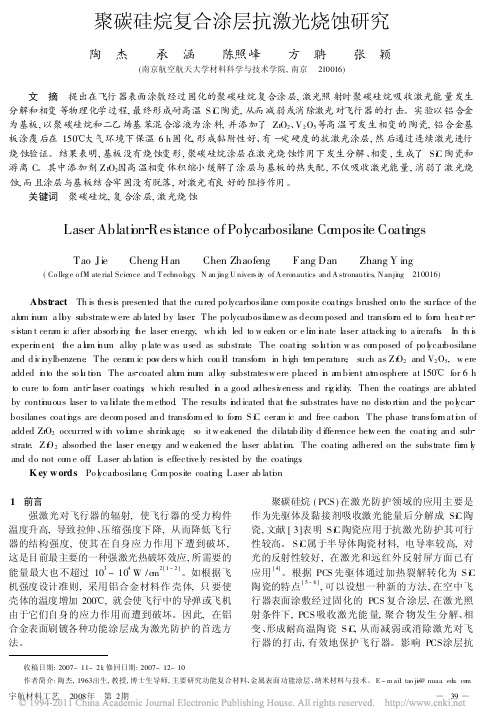
收稿日期:2007-11-21;修回日期:2007-12-10作者简介:陶杰,1963出生,教授,博士生导师,主要研究功能复合材料、金属表面功能涂层、纳米材料与技术。
E -m ai:l tao ji e @nuaa .edu.co m聚碳硅烷复合涂层抗激光烧蚀研究陶 杰 承 涵 陈照峰 方 聃 张 颖(南京航空航天大学材料科学与技术学院,南京 210016)文 摘 提出在飞行器表面涂敷经过固化的聚碳硅烷复合涂层,激光照射时聚碳硅烷吸收激光能量发生分解和相变等物理化学过程,最终形成耐高温S i C 陶瓷,从而减弱或消除激光对飞行器的打击。
实验以铝合金为基板,以聚碳硅烷和二乙烯基苯混合溶液为涂料,并添加了Zr O 2、V 2O 5等高温可发生相变的陶瓷,铝合金基板涂覆后在150 大气环境下保温6h 固化,形成黏附性好、有一定硬度的抗激光涂层,然后通过连续激光进行烧蚀验证。
结果表明,基板没有烧蚀变形,聚碳硅烷涂层在激光烧蚀作用下发生分解、相变,生成了Si C 陶瓷和游离C 。
其中添加剂Zr O 2因高温相变体积缩小缓解了涂层与基板的热失配,不仅吸收激光能量,消弱了激光烧蚀,而且涂层与基板结合牢固没有脱落,对激光有良好的阻挡作用。
关键词 聚碳硅烷,复合涂层,激光烧蚀Laser Ablati on Resi sta nce of Pol ycarbosilane Co mposite Coati ngsTao Jie Cheng Han Chen Zhaofeng Fang Dan Zhang Y ing(Co lleg e o fM ate rial Science and T echno l ogy ,N an ji ng U nivers it y of A eronauti cs and A stronauti cs ,N anji ng 210016)Abst ract Th is thesis presented that the cured po lycarbosilane co m posite coa ti n gs brushed onto the surface of the alum i n um a ll o y substrate w ere ab lated by laser .The po lycar bosilane w as deco m posed and transfor m ed to for m hea t resistan t cera m ic after absorb i n g t h e laser energy ,wh ic h led to w eaken or e li m i n ate laser attacking to a ircrafts .I n th i s experi m en,t the a l u m i n u m alloy p late w as used as substrate .The coati n g so l u ti o n w as co m posed of po l y car bosilane and d i v i n ylbenzene .The cera m ic po w ders w hich cou l d transfor m in high te m perature ,such as Zr O 2and V 2O 5,w ere added i n to the so l u ti o n .The as coated alum i n um alloy substratesw ere placed i n a m bient at m osphere at 150 for 6h to cure to for m anti laser coatings ,w hich resulted i n a good adhesi v eness and ri g idity .Then the coatings are ablated by conti n uous laser to va li d ate the m ethod .The results i n d icated that t h e substrates have no disto rtion and the po l y car bosilanes coati n gs are deco m posed and transfor m ed to for m S i C cera m ic and free car bon .The phase transfor m ati o n of added Zr O 2occurred w ith vo l u m e shrinkage ,so itw eakened the dilatab ility d ifference bet w een the coati n g and sub strate .Zr O 2absorbed the laser ener gy and w eakened the laser ablati o n.The coating adhered on the substrate fir m l y and do not co m e of.f Laser ab lation is effective ly resisted by the coatings .K ey w ords Po l y car bosilane ,Co m posite coati n g ,Laser ab lati o n 1 前言强激光对飞行器的辐射,使飞行器的受力构件温度升高,导致拉伸、压缩强度下降,从而降低飞行器的结构强度,使其在自身应力作用下遭到破坏,这是目前最主要的一种强激光热破坏效应,所需要的能量最大也不超过103~104W /c m 2[1~2]。
硅烷对分散和亚微粒子填充聚合物性能的影响
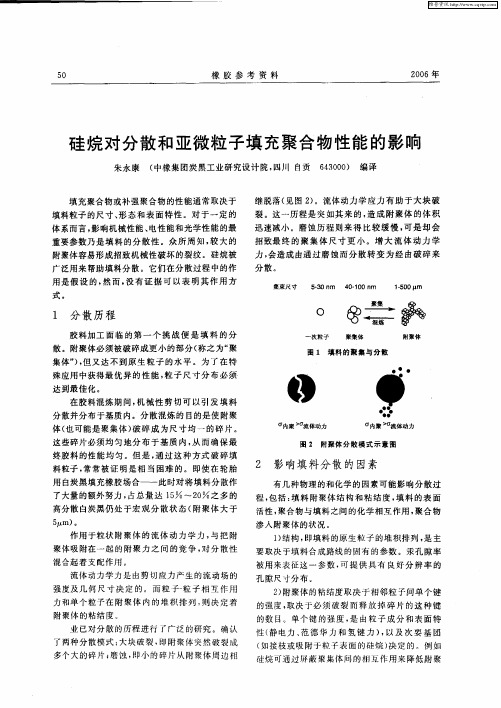
钙和 白炭黑填 充硅 酮树 脂 ) 。
料 相互 作 用 和附 聚体 的堆积 பைடு நூலகம்能 的改 变所致 。这
力和单 个粒子 在 附 聚体 内的 堆 积排 列 , 决 定 着 则
孔 隙尺 寸分布 。
2 附聚体 的粘结度 取决 于 相邻 粒 子间单 个键 )
的强 度 , 取决 于必 须 破裂 而 释 放 掉 碎 片 的这 种 键
附 聚体的粘结 度 。
业 已对分 散 的历程进 行 了广泛 的研 究 。确认
2 影 响 填 料分 散 的 因素
有几种 物理 的和化学 的 因素 可能 影 响分散 过 程, 包括 : 料 附聚 体结 构 和 粘 结 度 , 填 填料 的 表 面 活性 , 聚合 物与填 料之 间 的化 学 相互作 用 , 聚合 物 渗 入附聚 体的状 况 。
1结 构 , ) 即填料 的原生 粒子 的堆 积排 列 , 主 是 要 取决 于填料 合成路线 的固有 的参 数 。汞孔 隙率 被 用来表 征这 一参 数 , 提 供 具 有 良好 分 辨率 的 可
附聚体容 易形 成招致 机械性 破 坏的裂 纹 。硅烷 被 广泛用 来帮助 填料分 散 。它们 在分散 过 程 中的作
力, 会造成 由通 过磨 蚀 而 分 散转 变 为 经 由破 碎 来
分散。
集柬尺寸 5 3 m 4 ・0 m ・0 n 0 1 0r i 15 0 u - 0 m
了两 种分散 模式 : 大块破 裂 , 即附 聚体 突然破 裂成
《SiC_p增强2024铝基复合材料薄板的制备、显微组织与力学性能研究》

《SiC_p增强2024铝基复合材料薄板的制备、显微组织与力学性能研究》一、引言随着现代工业技术的快速发展,对于材料性能的要求越来越高。
在众多材料中,铝基复合材料以其轻质、高强、耐腐蚀等优点被广泛运用于航空、汽车等领域。
而硅碳化物(SiC_p)作为增强材料加入铝基复合材料中,能有效提高其性能。
本篇论文主要探讨了SiC_p增强2024铝基复合材料薄板的制备工艺、显微组织以及力学性能的研究。
二、制备工艺1. 材料选择本实验选择高纯度的铝和硅碳化物(SiC_p)作为原材料,同时选用2024铝合金作为基体材料。
2. 制备过程首先,将选定的铝和SiC_p进行预处理,然后按照一定比例混合,通过搅拌铸造法或粉末冶金法进行制备。
接着进行热压或热挤压处理,最后切割成薄板。
三、显微组织研究1. 显微组织观察利用光学显微镜(OM)、扫描电子显微镜(SEM)和透射电子显微镜(TEM)等设备对SiC_p增强2024铝基复合材料薄板的显微组织进行观察。
2. 显微组织分析观察结果显示,SiC_p均匀地分布在铝基体中,形成了良好的界面结合。
在热处理过程中,SiC_p和铝基体之间没有出现明显的反应,保持着良好的相容性。
此外,SiC_p的加入对铝基体的晶粒细化有明显效果。
四、力学性能研究1. 硬度测试通过维氏硬度计对SiC_p增强2024铝基复合材料薄板的硬度进行测试。
结果表明,随着SiC_p含量的增加,复合材料的硬度逐渐提高。
2. 拉伸性能测试利用拉伸试验机对SiC_p增强2024铝基复合材料薄板的抗拉强度、屈服强度和延伸率等力学性能进行测试。
实验结果显示,加入SiC_p能有效提高铝基复合材料的抗拉强度和屈服强度,同时保持较好的延伸率。
此外,合理的SiC_p含量能有效改善铝基体的塑性和韧性。
3. 疲劳性能测试通过疲劳试验机对SiC_p增强2024铝基复合材料薄板的疲劳性能进行测试。
结果表明,加入适量的SiC_p能有效提高铝基复合材料的疲劳寿命和抗疲劳性能。
不同碳化硅和球形石墨含量对混杂增强铝基复合材料力学性能的影响
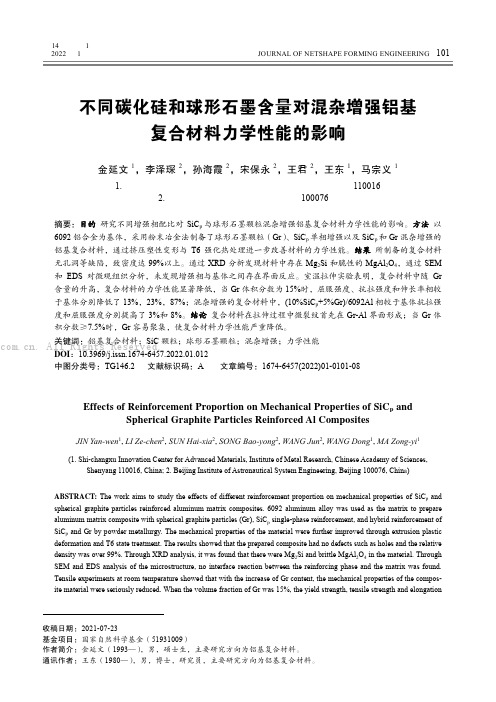
第14卷 第1期 精 密 成 形 工 程2022年1月JOURNAL OF NETSHAPE FORMING ENGINEERING101收稿日期:2021-07-23基金项目:国家自然科学基金(51931009) 作者简介:金延文(1993—),男,硕士生,主要研究方向为铝基复合材料。
不同碳化硅和球形石墨含量对混杂增强铝基复合材料力学性能的影响金延文1,李泽琛2,孙海霞2,宋保永2,王君2,王东1,马宗义1(1. 中国科学院金属研究所 师昌绪先进材料创新中心,沈阳 110016;2. 北京宇航系统工程研究所,北京 100076)摘要:目的 研究不同增强相配比对SiC p 与球形石墨颗粒混杂增强铝基复合材料力学性能的影响。
方法 以6092铝合金为基体,采用粉末冶金法制备了球形石墨颗粒(Gr )、SiC p 单相增强以及SiC p 和Gr 混杂增强的铝基复合材料,通过挤压塑性变形与T6强化热处理进一步改善材料的力学性能。
结果 所制备的复合材料无孔洞等缺陷,致密度达99%以上。
通过XRD 分析发现材料中存在Mg 2Si 和脆性的MgAl 2O 4,通过SEM 和EDS 对微观组织分析,未发现增强相与基体之间存在界面反应。
室温拉伸实验表明,复合材料中随Gr 含量的升高,复合材料的力学性能显著降低,当Gr 体积分数为15%时,屈服强度、抗拉强度和伸长率相较于基体分别降低了13%,23%,87%;混杂增强的复合材料中,(10%SiC p +5%Gr)/6092Al 相较于基体抗拉强度和屈服强度分别提高了3%和8%。
结论 复合材料在拉伸过程中微裂纹首先在Gr-Al 界面形成;当Gr 体积分数≥7.5%时,Gr 容易聚集,使复合材料力学性能严重降低。
关键词:铝基复合材料;SiC 颗粒;球形石墨颗粒;混杂增强;力学性能DOI :10.3969/j.issn.1674-6457.2022.01.012中图分类号:TG146.2 文献标识码:A 文章编号:1674-6457(2022)01-0101-08Effects of Reinforcement Proportion on Mechanical Properties of SiC p andSpherical Graphite Particles Reinforced Al CompositesJIN Yan-wen 1, LI Ze-chen 2, SUN Hai-xia 2, SONG Bao-yong 2, WANG Jun 2, WANG Dong 1, MA Zong-yi 1(1. Shi-changxu Innovation Center for Advanced Materials, Institute of Metal Research, Chinese Academy of Sciences,Shenyang 110016, China; 2. Beijing Institute of Astronautical System Engineering, Beijing 100076, Chin a ) ABSTRACT: The work aims to study the effects of different reinforcement proportion on mechanical properties of SiC p and spherical graphite particles reinforced aluminum matrix composites. 6092 aluminum alloy was used as the matrix to prepare aluminum matrix composite with spherical graphite particles (Gr), SiC p single-phase reinforcement, and hybrid reinforcement of SiC p and Gr by powder metallurgy. The mechanical properties of the material were further improved through extrusion plastic deformation and T6 state treatment. The results showed that the prepared composite had no defects such as holes and the relative density was over 99%. Through XRD analysis, it was found that there were Mg 2Si and brittle MgAl 2O 4 in the material. Through SEM and EDS analysis of the microstructure, no interface reaction between the reinforcing phase and the matrix was found. Tensile experiments at room temperature showed that with the increase of Gr content, the mechanical properties of the compos-ite material were seriously reduced. When the volume fraction of Gr was 15%, the yield strength, tensile strength and elongation. All Rights Reserved.102精密成形工程 2022年1月were reduced by 13%, 23% and 87% respectively compared with the matrix. In the hybrid reinforced composite material, com-pared to the matrix, the tensile strength and yield strength of (10%SiC p+5%Gr)/6092Al increased by 3% and 8%, respectively.Fracture analysis shows that microcracks first form at the Gr-Al interface during the stretching process; when the volume frac-tion Gr is ≥7.5%, Gr is likely to aggregate, which seriously reduces the mechanical properties of the composite material.KEY WORDS: aluminum matrix composites; SiC particles; spherical graphite particles; hybrid reinforcement; mechanical properties铝及其合金由于高比强度[1]、高抗腐蚀性[2]、良好的导热性[3]等特点已在航空航天、船舶和汽车等行业广泛应用[4-6]。
聚碳硅烷热解产物抗氧化性能的研究
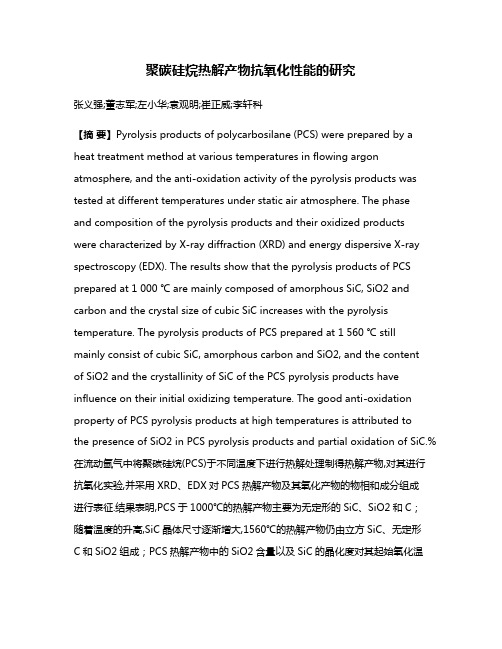
聚碳硅烷热解产物抗氧化性能的研究张义强;董志军;左小华;袁观明;崔正威;李轩科【摘要】Pyrolysis products of polycarbosilane (PCS) were prepared by a heat treatment method at various temperatures in flowing argon atmosphere, and the anti-oxidation activity of the pyrolysis products was tested at different temperatures under static air atmosphere. The phase and composition of the pyrolysis products and their oxidized products were characterized by X-ray diffraction (XRD) and energy dispersive X-ray spectroscopy (EDX). The results show that the pyrolysis products of PCS prepared at 1 000 ℃ are mainly composed of amorphous SiC, SiO2 and carbon and the crystal size of cubic SiC increases with the pyrolysis temperature. The pyrolysis products of PCS prepared at 1 560 ℃ still mainly consist of cubic SiC, amorphous carbon and SiO2, and the contentof SiO2 and the crystallinity of SiC of the PCS pyrolysis products have influence on their initial oxidizing temperature. The good anti-oxidation property of PCS pyrolysis products at high temperatures is attributed tothe presence of SiO2 in PCS pyrolysis products and partial oxidation of SiC.%在流动氩气中将聚碳硅烷(PCS)于不同温度下进行热解处理制得热解产物,对其进行抗氧化实验,并采用XRD、EDX对PCS热解产物及其氧化产物的物相和成分组成进行表征.结果表明,PCS于1000℃的热解产物主要为无定形的SiC、SiO2和C;随着温度的升高,SiC晶体尺寸逐渐增大,1560℃的热解产物仍由立方SiC、无定形C和SiO2组成;PCS热解产物中的SiO2含量以及SiC的晶化度对其起始氧化温度有一定影响;热解产物中SiO2、SiC氧化形成的SiO2使得PCS热解产物在高温下具有良好的抗氧化性能.【期刊名称】《武汉科技大学学报(自然科学版)》【年(卷),期】2012(035)004【总页数】4页(P289-292)【关键词】热解;聚碳硅烷;SiC;晶相;抗氧化【作者】张义强;董志军;左小华;袁观明;崔正威;李轩科【作者单位】武汉科技大学化学工程与技术学院,湖北武汉,430081;武汉科技大学化学工程与技术学院,湖北武汉,430081;黄石理工学院化学与材料工程学院,湖北黄石,435003;武汉科技大学化学工程与技术学院,湖北武汉,430081;武汉科技大学化学工程与技术学院,湖北武汉,430081;武汉科技大学化学工程与技术学院,湖北武汉,430081【正文语种】中文【中图分类】TQ317.9SiC是一种重要的高温结构材料,它具有良好的高温强度、高温稳定性和高温抗氧化性能[1]。
硅烷交联高密度聚乙烯热收缩材料性能的研究
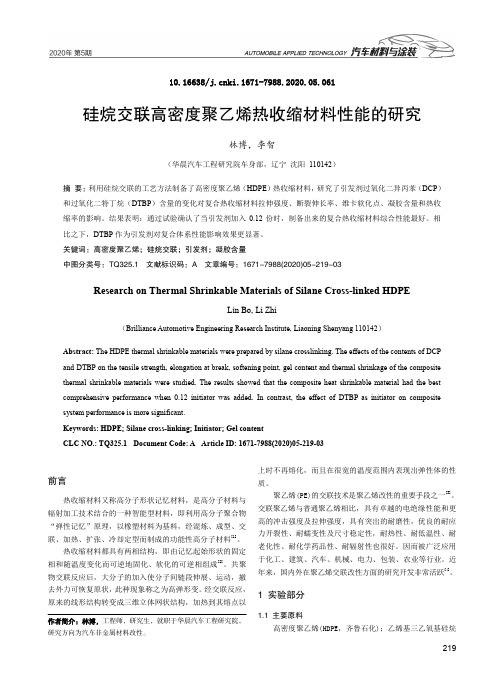
10.16638/ki.1671-7988.2020.05.061硅烷交联高密度聚乙烯热收缩材料性能的研究林博,李智(华晨汽车工程研究院车身部,辽宁沈阳110142)摘要:利用硅烷交联的工艺方法制备了高密度聚乙烯(HDPE)热收缩材料,研究了引发剂过氧化二异丙苯(DCP)和过氧化二特丁烷(DTBP)含量的变化对复合热收缩材料拉伸强度、断裂伸长率、维卡软化点、凝胶含量和热收缩率的影响。
结果表明:通过试验确认了当引发剂加入0.12份时,制备出来的复合热收缩材料综合性能最好。
相比之下,DTBP作为引发剂对复合体系性能影响效果更显著。
关键词:高密度聚乙烯;硅烷交联;引发剂;凝胶含量中图分类号:TQ325.1 文献标识码:A 文章编号:1671-7988(2020)05-219-03Research on Thermal Shrinkable Materials of Silane Cross-linked HDPELin Bo, Li Zhi(Brilliance Automotive Engineering Research Institute, Liaoning Shenyang 110142)Abstract: The HDPE thermal shrinkable materials were prepared by silane crosslinking. The effects of the contents of DCP and DTBP on the tensile strength, elongation at break, softening point, gel content and thermal shrinkage of the composite thermal shrinkable materials were studied. The results showed that the composite heat shrinkable material had the best comprehensive performance when 0.12 initiator was added. In contrast, the effect of DTBP as initiator on composite system performance is more significant.Keywords: HDPE; Silane cross-linking; Initiator; Gel contentCLC NO.: TQ325.1 Document Code: A Article ID: 1671-7988(2020)05-219-03前言热收缩材料又称高分子形状记忆材料,是高分子材料与辐射加工技术结合的一种智能型材料,即利用高分子聚合物“弹性记忆”原理,以橡塑材料为基料,经混炼、成型、交联、加热、扩张、冷却定型而制成的功能性高分子材料[1]。
基于聚碳硅烷直接固化的2D CSiC复合材料粘接方法与室温粘接性能
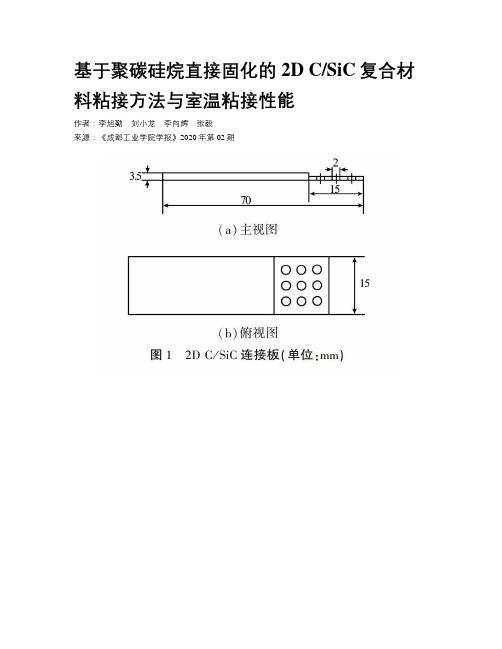
基于聚碳硅烷直接固化的2D C/SiC复合材料粘接方法与室温粘接性能作者:李旭勤刘小龙李向辉张毅来源:《成都工业学院学报》2020年第02期摘要:为了研究2D C/SiC复合材料的可粘接性,采用聚碳硅烷(PCS)作为粘接剂,经室温固化直接粘接2D C/SiC复合材料。
通过测试2D C/SiC连接板在粘接前后的三点弯性能,研究2D C/SiC复合材料的粘接效率,并采用有限元仿真模拟2D C/SiC粘接层的受力状态,揭示其内应力分布。
结果表明,PCS可用作2D C/SiC复合材料的室温粘接剂,2D C/SiC粘接件表现出与2D C/SiC复合材料相似的弯曲行为,其平均弯曲强度为126.46±23.95 MPa,粘接效率为41.62%。
有限元计算表明,在理想状况下,板以及粘接层能保持为一个整体,不开裂,强度最高,粘接效果最好;当粘接层的材料属性离样板的材料属性越来越远时,两者受力不一致,最终导致开裂,粘接效果差。
關键词:2D C/SiC;连接;强度;有限元仿真中图分类号:TB332 文献标志码:A文章编号:2095-5383(2020)02-0015-05Abstract: In order to study the bondability of 2D C/SiC composites, polycarbosilane (PCS) was used as a binder to directly bond 2D C/SiC composites at room temperature. By testing the three-point bending performance of 2D C/SiC connecting plates before and after bonding, the bonding efficiency of 2D C/SiC composites was studied. The stress state of 2D C/SiC bonding layer was simulated by finite element simulation, revealing internal stress distribution. The results show that PCS can be used as a room temperature adhesive for 2D C/SiC composites. The 2D C/SiC adhesive joints exhibit similar bending behavior as 2D C/SiC composites, with an average bending strength of 126.46±23.95 MPa. The bonding efficiency was 41.62%. The finite element calculation shows that under ideal conditions, the plate and the bonding layer can be kept as a whole without cracking, the strength and the bonding effect is best; when the material properties of the bonding layer are far away from the template, the two forces are inconsistent, which eventually leading to cracking and poor bonding effect.Keywords:2D C/SiC;joining;strength;finite element analysis连续碳纤维增韧补强碳化硅陶瓷基复合材料(C/SiC)具有低密度、耐高温、高强度、高韧性,高导热、耐磨损、稳定耐腐蚀等优异性能,成为继C/C复合材料后的新型热结构材料[1-5]。
铁镍铜碳合金粗粉注射成形件的力学性能和微观组织
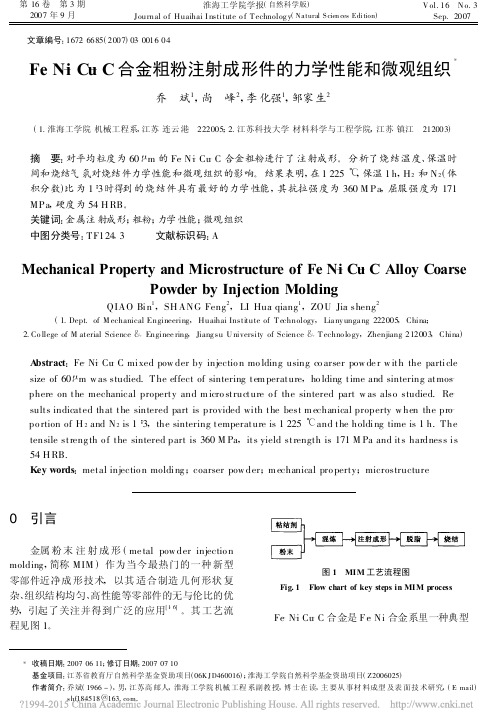
第16卷第3期2007年9月淮海工学院学报(自然科学版)Journal o f Huaihai I nstitute o f T echnolog y (Natural S cien ces Edition )V ol.16 N o.3Sep.2007 文章编号:1672-6685(2007)03-0016-04Fe -Ni -Cu -C 合金粗粉注射成形件的力学性能和微观组织*乔 斌1,尚 峰2,李化强1,邹家生2(1.淮海工学院机械工程系,江苏连云港 222005;2.江苏科技大学材料科学与工程学院,江苏镇江 212003)摘 要:对平均粒度为60μm 的Fe -Ni -Cu -C 合金粗粉进行了注射成形。
分析了烧结温度、保温时间和烧结气氛对烧结件力学性能和微观组织的影响。
结果表明,在1225℃,保温1h ,H 2和N 2(体积分数)比为1∶3时得到的烧结件具有最好的力学性能,其抗拉强度为360M Pa ,屈服强度为171MPa ,硬度为54H RB 。
关键词:金属注射成形;粗粉;力学性能;微观组织中图分类号:TF124.3 文献标识码:AMechanical Property and Microstructure of Fe -Ni -Cu -C Alloy CoarsePowder by Injection MoldingQIAO Bin 1,SH ANG Feng 2,LI Hua -qiang 1,ZOU Jia -sheng 2(1.Dept.of M echanical Engineering ,Huaihai Institute of T echnology ,Lia ny unga ng 222005,China ;2.Co llege of M aterial Science &Enginee ring ,Jiang su U niversity of Science &T echno lo gy ,Zhenjiang 212003,China )A bstract :Fe -Ni -Cu -C mixed pow der by injectio n mo lding using co arser pow de r w ith the particle size of 60μm w as studied.The effect of sintering tem perature ,ho lding time and sintering atmos -phere on the mechanical property and m icro structure o f the sintered part w as also studied.Re -sults indicated that the sintered part is provided with the best m echanical property w hen the pro -po rtion of H 2and N 2is 1∶3,the sintering temperature is 1225℃and the holding time is 1h.The tensile streng th o f the sintered part is 360M Pa ,its yield strength is 171M Pa and its hardness is 54H RB.Key words :metal injectio n molding ;coarser pow der ;m echanical pro perty ;microstructure0 引言金属粉末注射成形(me tal pow der injectio n molding ,简称MIM )作为当今最热门的一种新型零部件近净成形技术,以其适合制造几何形状复杂、组织结构均匀、高性能等零部件的无与伦比的优势,引起了关注并得到广泛的应用[1-6]。
碳含量对金属注射成形17-4PH不锈钢显微组织和力学性能的影响
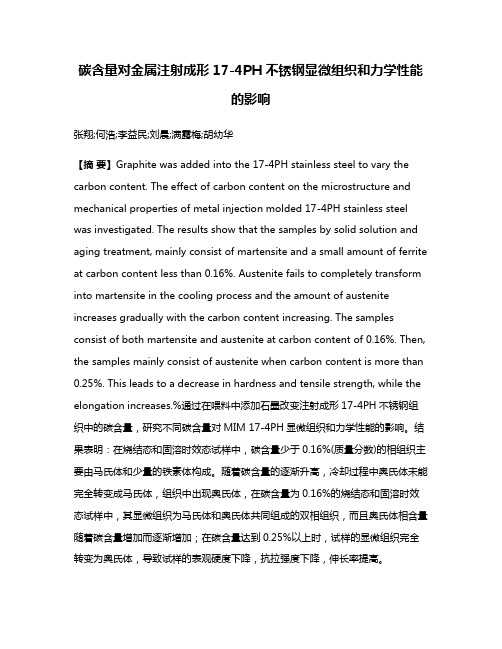
碳含量对金属注射成形17-4PH不锈钢显微组织和力学性能的影响张翔;何浩;李益民;刘晨;满露梅;胡幼华【摘要】Graphite was added into the 17-4PH stainless steel to vary the carbon content. The effect of carbon content on the microstructure and mechanical properties of metal injection molded 17-4PH stainless steel was investigated. The results show that the samples by solid solution and aging treatment, mainly consist of martensite and a small amount of ferrite at carbon content less than 0.16%. Austenite fails to completely transform into martensite in the cooling process and the amount of austenite increases gradually with the carbon content increasing. The samples consist of both martensite and austenite at carbon content of 0.16%. Then, the samples mainly consist of austenite when carbon content is more than 0.25%. This leads to a decrease in hardness and tensile strength, while the elongation increases.%通过在喂料中添加石墨改变注射成形17-4PH不锈钢组织中的碳含量,研究不同碳含量对MIM 17-4PH显微组织和力学性能的影响。
静电纺聚碳硅烷制备SiOC超细纤维

静电纺聚碳硅烷制备SiOC超细纤维吴楠;WAN Lynn Yuqin;王应德;FRANK KO【摘要】以聚碳硅烷(PCS)为先驱体, 采用静电纺丝法和先驱体转化法制备SiOC 超细纤维, 研究PCS溶液浓度和表面活性剂对纤维形貌和直径的影响.实验结果表明: 添加表面活性剂后, 纤维分布均匀, 串珠现象消失; 通过调节溶液中PCS比例, 纤维直径分布范围为500~900 nm.力学性能测试表明SiOC纤维毡的抗拉强度可达8.88 MPa.SiOC超细纤维毡也展现出优异的热稳定性和抗化学腐蚀性能, 在苛刻环境中可以作为催化剂载体和过滤材料使用.%Siliconoxycarbide(SiOC)ultrafine fibers with uniform distribution were prepared via electrospinning of polycarbosilane (PCS)/polystyrene followed by oxidation and pyrolysis at 1100℃. The diameter of SiOC fibers ranged from 500 to 900 nm through adjusting PCS concentration. The average tensile strength of SiOC fiber mat was 8.88 MPa. The obtained SiOC fibers also displayed outstanding thermal stability and chemical resistance, making them promising materials as smart filters and catalyst supports in harsh environment.【期刊名称】《无机材料学报》【年(卷),期】2018(033)003【总页数】6页(P357-362)【关键词】静电纺丝;聚碳硅烷;硅氧碳;陶瓷纤维【作者】吴楠;WAN Lynn Yuqin;王应德;FRANK KO【作者单位】国防科技大学新型陶瓷纤维及其复合材料重点实验室,长沙 410073;不列颠哥伦比亚大学材料工程系,温哥华 V6T 1Z4;不列颠哥伦比亚大学材料工程系,温哥华 V6T 1Z4;国防科技大学新型陶瓷纤维及其复合材料重点实验室,长沙410073;不列颠哥伦比亚大学材料工程系,温哥华 V6T 1Z4【正文语种】中文【中图分类】TQ174Owing to the excellent high-temperature resistance and mechanical properties, silicon-based ceramic fibers have been widely applied in aerospace and nuclear energy fields[1]. Particularly, ultrafine SiC or SiOC fibers have received much more attention due to their high surface-to-volume ratio, which demonstrated potential applications as catalyst supports[2], filtration device[3], and composite membrane[4].Among various chemical and physical synthesis methods, electrospinning is considered as a simple and versatile method for production of continuous ceramic micro/nanofibers in large scale[5]. Recently, we have successfully fabricated hierarchically porous SiC microfibers[6] andZrO2/SiC gradient fibers[7] using electrospinning combined with polymer derived ceramic (PDC) techniques. PDC route is a prominent method for the fabrication of silicon-based ceramic materials, especially for the fiber and layer forms, which is a challenge to the traditional powder technology[8].Polycarbosilane (PCS) known as the most common precursor polymer for the synthesis of silicon-based ceramic fibers since invented by Yajima[9].However, the fabrication of SiOC ultrafine fibers with uniform distribution d iameter below 1 μm through electrospinning of PCS is rarely reported due to the low molecular weight of PCS with large amounts of branched chains, which requires a high mass ratio of about 60% in aprotic solvent for electrospinning. Though the Si(O)C nanofibers have been fabricated by core-shell electrospinning[10-11], the complicated process and inhomogeneous fiber morphology greatly limited their large-scale production and application.Herein, we prepared beads-free SiOC fibers by electrospinning of PCS droplets entrapped with the polystyrene (PS) solution followed by oxidation and high-temperature pyrolysis. The diameter of the obtained fibers ranges from 500 nm to 900 nm through adjusting PCS concentration in the solution. The thermal stability, erosion resistance and mechanical strength of fiber mat were also investigated in this work.Polystyrene (PS, Mn=1,928,000, Scientific polymer production INC), polycarbosilane (PCS, prepared in CFC, National University of Defense Technology), Sodium dodecyl sulfate (SDS, MP Biomedicals), xylene (Fisher scientific) and dimethylformamide (DMF, Anachemia) were used without purification.In a typical process, 3wt% PS was dissolved into the mixed solvent of xylene and DMF. Then, PCS and SDS were added to the PS solution and stirred at room temperature for 12 h until a transparent solution was obtained. Electrospinning was conducted by a Drum Electrospinning Unit (Kato Tech Inc., Japan). The precursor solution was transferred into a 10 mlsyringe with a constant flow rate of 0.8 mL/h. A high voltage of 11-13 kV was applied between the metal needle and the grounded drum. The relative humidity was controlled at 25%-30%. After electrospinning, the as-spun fiber membrane was stabilized at 210℃ for 2 h at a ramp rate of1℃/min. Calcination was done at 1100℃ for 2 h under Ar atmosphere. The final SiOC-x is named after the weight concentration of PCS. The concentration of PCS in the spinning solution of SiOC-9, SiOC-15 and SiOC-21 are 9wt%, 15wt% and 21wt%, respectively.The morphology of fibers was studied by scanning electron microscopy (SEM, Hitachi S-3000, Japan). The average diameter of the ultrafine fibers was obtained through analyzing about 150 fibers by ImageJ software. X-ray diffraction (XRD) patterns were collected i n the range of 10°-80° using Rigaku multiflex diffractometer. X-ray photoelectron spectroscopy (XPS) was carried out on a Thermo Scientific Escalab 250Xi machine. Thermal gravimetric analysis (TGA) was operated on TGA Q500 instrument in air at a ramping ra te of 10 ℃/min. The tensile strength of the fiber mats were tested on a Kawabata KES-G1 microtensile tester as described in the previous paper[12]. The results of the experiment were expressed in load (gram force) vs. displacement. The specific stress in g/Tex was then calculated using the following equation:Then the specific stress in g/Tex was converted to engineering stress by the equation below:The strain was calculated by dividing the displacement by the gauge length.In this study, high-molecular weight PS was introduced into the spinning solution to decrease the required PCS concentration for electrospinningand facilitate the electrospinning process. Previous study showed that low molecular weight polymer with dilute concentration can be electrospun in emulsion phase[13]. Surfactant is of vital important for emulsion electrospinning, which can decrease the surface tension and improve the dispersion uniformity of the micelles in the matrix solution[14]. SDS was chosen as the surfactant to facilitate the electrospinning process in this work. Figure 1(a) shows beaded fibers were obtained from the solution without SDS. The presence of beads in the fibers usually weakens the mechanical properties of fiber mats. Addition of 1wt% SDS eliminated the formation of beads, as shown in Fig. 1(b). This implied that the addition of SDS lowered the surface tension and enhanced the rheological property, further improved the uniformity of the resultant fibers. As can be seenfrom Fig. 1(b), the as-spun fibers had a wrinkled skin which was a consequence of the rapid evaporation of solvent in the low humidity environment (30% relative humidity)[15]. The diameter of as-spun SiOC-15 fibers was measured to be (900±300) nm. The fiber diameter decreased slightly to (820±320) nm after stabilization process while the surface became smoother due to the shrinkage (Fig. 1(c)). After pyrolyzed at 1100℃ in argon, the diameter of SiOC-15 further decreased to (630±125) nm and the fiber mat shrinked about 24.4% compared to pre-oxidized mat (the fiber mat area changed from 21.1 to 16 cm2, Fig. 1(d)).The viscosity of solution plays an important role in determining thediameter of obtained fibers. High viscosity increases the relaxation time and hinders the elongation of the ejected jets, resulting in larger fiber diameter[16]. Here, the effects of the concentration of PCS in the solution on SiOC fiber diameter we investigated. SEM images revealed the corresponding morphology of the fibers as shown in Fig. 2. All the three fibers are free of beads and uniform with wrinkled surface after pyrolysis. The wrinkled surface of SiOC fibers suggests that the fibers have potential applications as catalyst carriers with increased number of active anchors for catalysts. The diameter distribution for SiOC-9, SiOC-15 and SiOC-21 was summarized in the insets of Fig. 2. As expected, the average diameter of SiOC fiber decreased from 875 nm to 505 nm as the PCS concentration decreased from 21wt% to 9wt%. The elemental composition of different SiOC fibers was analyzed by EDS. Ignoring the small contents of sodium, sulfur and gold, the atomic proportion of SiOC-9 was found to be about 16.3% Si, 30.1% O and 53.6% C. The SiOC ceramics with high carbon content possessed better mechanical properties with improved creep and oxidation resistance[17].The chemical status of the existed elements was analyzed by XPS, as shown in Fig. 3. XPS survey scan indicates the presence of sodium, oxygen, carbon and silicon (Fig. 3(a)). The small content of sodium (2.5%) came from the addition of SDS. In the C1s spectrum of SiOC-15, a noticeable characteristic peak for C-C bond at 284.6 eV was observed, suggesting the existence of free carbon in the carbonized fibers. A peak at around 284.0 eV characterizing SiOxCy was also detected. The Si2p spectrum in Fig. 3(c)proved the existence of SiO2(103.5 eV), SiO3C (102.9 eV), SiO2C2 (102.4 eV) and SiOC3 (101.6 eV) on the surface of fibers[18]. As shown in Fig. 3(d), the peak for SiOxCy at 532.4 eV was also found in the O1s spectrum. All the above results demonstrated that the obtained SiOC fiber surface was mainly composed of free carbon and SiOxCy phase.Typical stress-strain tensile properties of the SiOC fiber mats are shown in Fig. 4. The average tensile strength for SiOC-9, SiOC-15 and SiOC-21 is0.45 MPa, 2.24 MPa and 8.88 MPa, respectively. Wan et al. have showed that low fiber packing density (high porosity) of nonwoven mats will decrease the mechanical strength of the mats[19]. The low porosity and high bulk density contribute mostly to the relatively higher tensile strength of SiOC-21. SiOC-15 demonstrated a platform-ladder like broken model which was different from SiOC-9 and SiOC-21. This was attributed to the existence of laminar fracture in the mat, as confirmed by SEM (on the right of Fig. 4). Besides, a pseudo-yield point was observed in SiOC-15 curve, caused by the fiber slippage[12].Thermal stability and erosion resistance are important for the future practical applications of SiOC fibers in harsh environment. The thermal stability of samples was investigated with TGA by treating the samples at high-temperature in air. Figure 5(a) shows the TGA curve of SiOC-15. The residual weight slightly increased when the treatment temperature went above 500℃ as SiOC phase was conver ted into SiO2. The morphology of SiOC-15 fibers displayed no change after 1h treating in air at 500℃ (inset of Fig. 5(a)), suggesting an excellent thermal stability of the SiOC ultrafinefibers at high temperature. The erosion experiment showed that the SiOC fibers maintained their integral features after treated in hot H2SO4 and KOH solution (Fig. 5(b) and (c)). XRD patterns in Fig. 5(d) confirmed that there is no phase transformation after the harsh treatments. The good thermal stability and erosion resistance indicated potential applications of the SiOC ultrafine fibers as catalyst supports and filters in harsh environment.In conclusion, SiOC fibers with average diameter of 500 nm to 875 nm were successfully prepared by electro- spinning of different concentration PCS/PS solution, followed by pre-oxidation and pyrolysis. The SiOC fibers display enhanced thermal stability at 500℃ in air and excellent chemical resistance. These outstanding properties of obtained SiOC fiber mats make them promising candidates for filters and catalyst supports in harsh environment.【相关文献】[1] YUAN Q, SONG Y. Research and development of continous SiC fiber and SiCf/SiC composites. Journal of Inorganic Materials, 2016, 31(11): 1157–1165.[2] Hojamberdiev M, Prasad R M, Morita K, et al. Polymer-derived mesoporous SiOC/ZnO nanocomposite for the purification of water contaminated with organic dyes. Microporous and Mesoporous Materials, 2012, 151: 330–338.[3] Vanhaecke E, Ivanova S, Deneuve A, et al. 1D SiC decoration of SiC macroscopic shapes for filtration devices. Journal of Materials Chemistry, 2008, 18: 4654–4662.[4] Kim T E, Juon S M, Park J H, et al. Silicon carbide fiber-reinforced composite membrane for high-temperature and low-humidity polymer exchange membrane fuel cells. International Journal of Hydrogen Energy, 2014, 39(29): 16474–16485.[5] Wu N, Wang Y, Lei Y,et al. Electrospun interconnected Fe-N/C nanofiber networksas efficient electrocatalysts for oxygen reduction reaction in acidic media. Scientific Reports, 2015, 5: 17396.[6] Wang B, Wang Y, Lei Y, et al. Hierarchically porous SiC ultrathin fibers mat with enhanced mass transport, amphipathic property and high-temperature erosion resistance. Journal of Materials Chemistry A, 2014, 2(48): 20873–20881.[7] Wang Y, Han C, Zheng D, et al. Large-scale, flexible and high-temperature resistant ZrO2/SiC ultrafine fibers with a radial gradient composition. Journal of Materials Chemistry A, 2014, 2(25): 9607–9612.[8] Colombo P, Mera G, Riedel R,et al. Polymer-derived ceramics: 40 years of research and innovation in advanced ceramics. Journal of the American Ceramic Society, 2010, 93: 1805–1837.[9] CHENG X, XIE Z, SONG Y, et al. Structure and properties of polycarbosilane synthesized from polydimethylsilane under high pressure. Journal of Applied Polymer Science, 2006, 99(3): 1188–1194.[10] Liu H, Balkus K J. Electrospinning of beta silicon carbide nanofibers. Materials Letters, 2009, 63(27): 2361–2364.[11] Eick B M, Youngblood J P. SiC nanofibers by pyrolysis of electrospun preceramic polymers. Journal of Materials Science, 2009, 44(1): 160–165.[12] Ayutsede J, Gandhi M, Sukigara S, et al. Regeneration of bombyx mori silk by electrospinning. part 3: characterization of electrospun nonwoven mat. Polymer, 2005,46(5): 1625–1634.[13] Hu J, Prabhakaran M P, Ding X. Emulsion electrospinning of polycaprolactone: influence of surfactant type towards the scaffold properties. Journal of Biomaterials Science, Polymer,2015, 26(1): 57–75.[14] Li Y, Ko F K, Hamad W Y. Effects of emulsion droplet size on the structure of electrospun ultrafine biocomposite fibers with cellulose nanocrystals. Biomacromolecules, 2013, 14: 3801–3807.[15] KOOBHONGSE S, LIU W, RENEKER D. Flat polymer ribbons and other shapes by electrospinning. Journal of Polymer Science Part B: Polymer Physics, 2001, 39(1): 2363–2377.[16] Jiang H, Fang D, Hsiao B S,et al. Optimization and characterization of dextran membranes prepared by electrospinning. Biomacromolecules, 2004, 5(2): 326–333.[17] Kleebe H J, Blum Y D. SiOC ceramic with high excess free carbon. Journal of the European Ceramic Society, 2008, 28(5): 1037–1042.[18] Kim M, Kim J. Redox deposition of birnessite-type manganese oxide on silicon carbide microspheres for use as supercapacitor electrodes. ACS Applied Materials and Interfaces, 2014, 6(12): 9036–9045.[19] Wan L Y, Wang H, Gao W,et al. An analysis of the tensile properties of nanofiber mats. Polymer, 2015, 73: 62–67.。
聚碳硅烷表面张力的测定及其对纤维异形度的影响机理
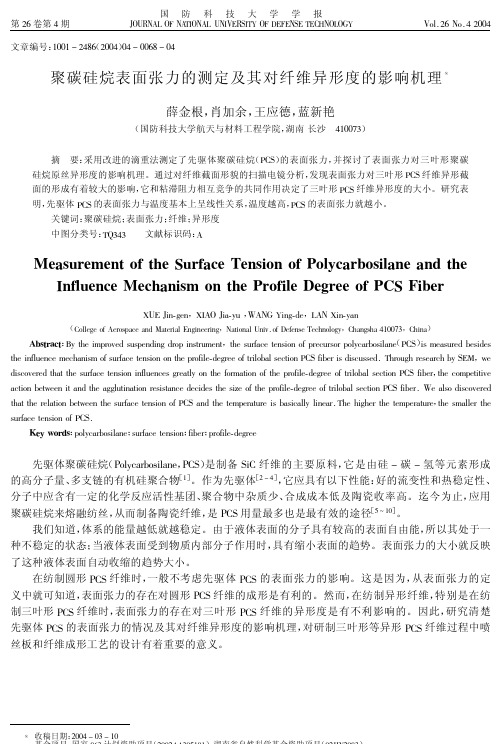
国防科技大学学报第26卷第4期JOURNAL OF NA TIONAL UNIVERSITY OF DEFENSE TECHNOLO Y Vol.26No.42004文章编号:1001-2486(2004)04-0068-04聚碳硅烷表面张力的测定及其对纤维异形度的影响机理!薛金根,肖加余,王应德,蓝新艳(国防科技大学航天与材料工程学院,湖南长沙410073)摘要:采用改进的滴重法测定了先驱体聚碳硅烷(PCS)的表面张力,并探讨了表面张力对三叶形聚碳硅烷原丝异形度的影响机理。
通过对纤维截面形貌的扫描电镜分析,发现表面张力对三叶形PCS纤维异形截面的形成有着较大的影响,它和粘滞阻力相互竞争的共同作用决定了三叶形PCS纤维异形度的大小。
研究表明,先驱体PCS的表面张力与温度基本上呈线性关系,温度越高,PCS的表面张力就越小。
关键词:聚碳硅烷;表面张力;纤维;异形度中图分类号:TO343文献标识码:AMeasurement of the Surface Tension of Polycarbosilane and the Influence Mechanism on the Profile Degree of PCS FiberXUE Jin-gen,XIAO Jia-yu,WAN Ying-de,LAN Xin-yan(College of Aerospace and Material Engineering,National Univ.of Defense Technology,Changsha410073,China)Abstract:By the improved suspending drop instrument,the surface tension of precursor polycarbosilane(PCS)is measured besides the influence mechanism of surface tension on the profile-degree of trilobal section PCS fiber is discussed.Through research by SEM,we discovered that the surface tension influences greatly on the formation of the profile-degree of trilobal section PCS fiber,the competitive action between it and the agglutination resistance decides the size of the profile-degree of trilobal section PCS fiber.We also discovered that the relation between the surface tension of PCS and the temperature is basically linear.The higher the temperature,the smaller the surface tension of PCS.Key words:polycarbosilane;surface tension;fiber;profile-degree先驱体聚碳硅烷(Polycarbosilane,PCS)是制备SiC纤维的主要原料,它是由硅-碳-氢等元素形成的高分子量、多支链的有机硅聚合物[1]。
聚碳硅烷热解SiC陶瓷结构与微波吸收性能
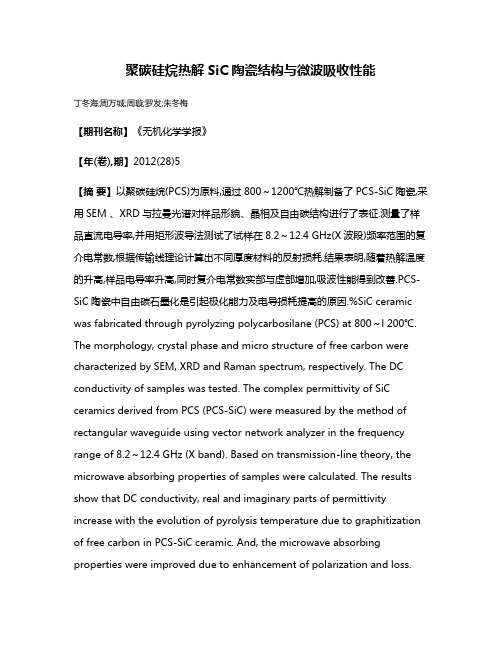
聚碳硅烷热解SiC陶瓷结构与微波吸收性能丁冬海;周万城;周璇;罗发;朱冬梅【期刊名称】《无机化学学报》【年(卷),期】2012(28)5【摘要】以聚碳硅烷(PCS)为原料,通过800~1200℃热解制备了PCS-SiC陶瓷,采用SEM 、XRD与拉曼光谱对样品形貌、晶相及自由碳结构进行了表征.测量了样品直流电导率,并用矩形波导法测试了试样在8.2~12.4 GHz(X波段)频率范围的复介电常数,根据传输线理论计算出不同厚度材料的反射损耗.结果表明,随着热解温度的升高,样品电导率升高,同时复介电常数实部与虚部增加,吸波性能得到改善.PCS-SiC陶瓷中自由碳石墨化是引起极化能力及电导损耗提高的原因.%SiC ceramic was fabricated through pyrolyzing polycarbosilane (PCS) at 800~l 200℃. The morphology, crystal phase and micro structure of free carbon were characterized by SEM, XRD and Raman spectrum, respectively. The DC conductivity of samples was tested. The complex permittivity of SiC ceramics derived from PCS (PCS-SiC) were measured by the method of rectangular waveguide using vector network analyzer in the frequency range of 8.2~12.4 GHz (X band). Based on transmission-line theory, the microwave absorbing properties of samples were calculated. The results show that DC conductivity, real and imaginary parts of permittivity increase with the evolution of pyrolysis temperature due to graphitization of free carbon in PCS-SiC ceramic. And, the microwave absorbing properties were improved due to enhancement of polarization and loss.【总页数】5页(P922-926)【作者】丁冬海;周万城;周璇;罗发;朱冬梅【作者单位】西北工业大学凝固技术国家重点实验室,西安710072;西北工业大学凝固技术国家重点实验室,西安710072;西北工业大学凝固技术国家重点实验室,西安710072;西北工业大学凝固技术国家重点实验室,西安710072;西北工业大学凝固技术国家重点实验室,西安710072【正文语种】中文【中图分类】TQ174【相关文献】1.热解温度对聚碳硅烷转化SiC陶瓷结构及介电性能的影响 [J], 丁冬海;周万城;周璇;罗发;朱冬梅2.空气中γ射线辐照聚碳硅烷陶瓷先驱丝热解合成SiC纤维 [J], 黎阳;许云书;徐光亮;熊亮萍;夏修龙3.电子束辐照聚碳硅烷热解合成SiC陶瓷材料Ⅱ.低分子量聚丁二烯对不熔化反应的敏化效应 [J], 许云书;傅依备;黄瑞良;孙颖;华德根4.热解温度对聚碳硅烷转化SiC陶瓷结构及介电性能的影响 [J], 丁冬海;周万城;周璇;罗发;朱冬梅;5.电子束辐照聚碳硅烷热解合成 SiC 陶瓷材料──I . 空气中辐照产物的热解特性研究 [J], 许云书;宋永才;傅依备;黄瑞良因版权原因,仅展示原文概要,查看原文内容请购买。
熔融纺丝过程优化制备细直径碳化硅纤维及其对力学性能的影响
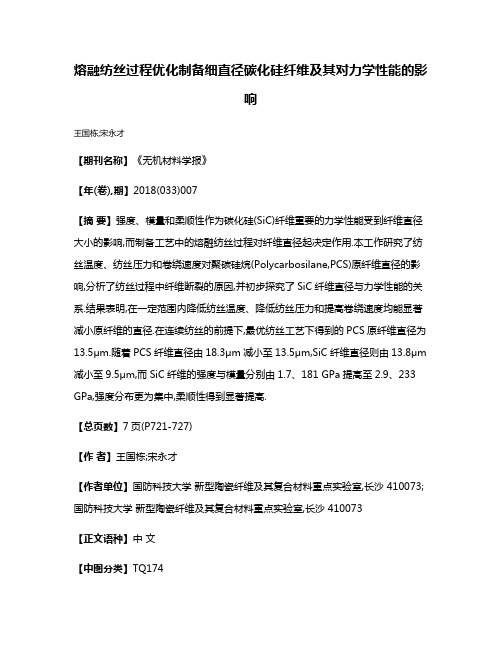
熔融纺丝过程优化制备细直径碳化硅纤维及其对力学性能的影响王国栋;宋永才【期刊名称】《无机材料学报》【年(卷),期】2018(033)007【摘要】强度、模量和柔顺性作为碳化硅(SiC)纤维重要的力学性能受到纤维直径大小的影响,而制备工艺中的熔融纺丝过程对纤维直径起决定作用.本工作研究了纺丝温度、纺丝压力和卷绕速度对聚碳硅烷(Polycarbosilane,PCS)原纤维直径的影响,分析了纺丝过程中纤维断裂的原因,并初步探究了SiC纤维直径与力学性能的关系.结果表明,在一定范围内降低纺丝温度、降低纺丝压力和提高卷绕速度均能显著减小原纤维的直径.在连续纺丝的前提下,最优纺丝工艺下得到的PCS原纤维直径为13.5μm.随着PCS纤维直径由18.3μm减小至13.5μm,SiC纤维直径则由13.8μm 减小至9.5μm,而SiC纤维的强度与模量分别由1.7、181 GPa提高至2.9、233 GPa,强度分布更为集中,柔顺性得到显著提高.【总页数】7页(P721-727)【作者】王国栋;宋永才【作者单位】国防科技大学新型陶瓷纤维及其复合材料重点实验室,长沙 410073;国防科技大学新型陶瓷纤维及其复合材料重点实验室,长沙 410073【正文语种】中文【中图分类】TQ174【相关文献】1.超细镍粉化学气相法制备过程中温度的影响 [J], 张淑英;陈滨;刘志宏2.电化学法制备超细Cu粉过程中油酸含量对粉体的影响 [J], 李维;毛健;李华峰;陈国需;蒋渝3.种分制备超细氢氧化铝过程分解率影响因素及结晶机理分析 [J], 王建立;宋为聪;李奉隆;黄信建;4.超细硼化锆粉体制备过程中的影响因素探究 [J], 王亚飞;段云彪;王开军;张维钧;傅强;胡劲5.种分法制备超细氢氧化铝过程控制影响因素研究 [J], 周俊文;刘明珠;王建立因版权原因,仅展示原文概要,查看原文内容请购买。
- 1、下载文档前请自行甄别文档内容的完整性,平台不提供额外的编辑、内容补充、找答案等附加服务。
- 2、"仅部分预览"的文档,不可在线预览部分如存在完整性等问题,可反馈申请退款(可完整预览的文档不适用该条件!)。
- 3、如文档侵犯您的权益,请联系客服反馈,我们会尽快为您处理(人工客服工作时间:9:00-18:30)。
i et n le e2 i txc m oiaeivs gtd T e eut so a:h ifre h s o Cp rls e n ci d d -N r o p st r net ae. h sl w t tte e ocdp ae f i yoyi d j o mo F ma i i r sh h rn S s
wU u HBiblioteka Xi-o QUXunh i F , nb . a・u
(c o l f t ilS i c n n ier g U iesyo S i c n eh ooyBeig B in 0 0 3 C i ) S h o o Ma r s ce e dE gn ei , nv r t f c n e dT cn lg On , e ig10 8 , hn e a n a n i e a j a
P S对 F 一Ni 金 的致 密度 、显 微 组 织 、力 学 性 能 及 断 口的 影 响 。 结 果表 明 :P S裂 解 生 成 的 SC 增 强 相 颗粒 C e2 合 C i
细小,在基 体材 料中分布均匀 ,加入 5 l%( %一 0 体积 分数)c v s可使材料抗拉强度提高 4 %~ 2 3 6 %,洛氏硬度提 高
b CS d srb t s h mo e e u l n mar ,c mp rg wi h a ls wi o t P h e sl sr n t f t e y P it u e o g n o sy i ti i x o ai t t e s mp e t u CS t e tn i te gh o h h h e
— —
20 07年 1 2月
De 0 7 c20
聚碳硅烷对注射成形 F .N 基 复合材料显微组织和 e i 2 力学性能 的影响
吴 福 ,何 新 波 , 曲选 辉
( 北京科 技大 学 材料科学与工程学 院,北京 10 8 ) 0 0 3
摘
要 :采 用 粉 末 注 射 成 形 工 艺 , 以聚 碳 硅烷 (c ) o s 为先 驱 材 料 ,制 得 SC颗 粒 增 强 的 F 一Ni 复 合 材 料 :研 究 i e2 基
维普资讯
第1 2卷第 6期
V0 2N O 6 11
. . . .
— —
粉末冶金材料科学与工程
M a e i l inc and Eng ne rng o t r a sSce e i e i fPowde e a l g rM t lur y
b te a i F t x c mp sts et r h n S C/ ema r o o i . t i e
Ke r sp l ab sl e me lnet nmodn ;e o s txcmp s e; ca i l rpr ywod : oy roi n ; t jc o l g f ru r o oi smehnc o et c a ai i i r mai t ap y
4 %- 7 0 4%,但伸长率下降, 由韧性 断裂转变成脆性断裂:F一Ni 复合材料 的强度和硬度 达到了 MI 协会 的标 e 2 基 M
准 ,优 于 SC颗 粒 增 强 的 F 基 复 合 材 料 。 i e
关键词 :聚碳硅烷:金属注射成形:铁基 复合材料 ;力学性能 中图分类号 :T 2 F 14 文献标识码 :A 文章编 号:17 —2 42 0 )—4 .5 6 30 2 (0 763 90
.
adhrn s o e e2 o oi s ai e e tn ado eMe lnet nModn ( M1 sc t na d r n ad es fh 一Ni mp s e t f sh ad r fh t jc o l g MI o i i ae t F c t s s t s i t aI i i As a o n
c mp stswi % 一1 %P n ra e b u 3 - 2 a dteHRB h r n s n ra e b u 0 一 7 wh l h o oi t 5 e h 0 CS ice s sa o t % 6 % n h 4 ad e sice s sa o t % 4 % 4 i te e
A src:T eif ecso oyabs aeP S n dni , cot c r, ca i lpo et sa df c r o b tat h n un e fP l roi n(C )o e s mi s u t e mehnc rpre n r t e f l c l y t r r u a i au
I fu nc fP0 y a b0 i n d ii n o e ha i a o r i sa n e e o l c r sl e a d to n m c n c l l a pr pe te nd m i r s r c ur f 一 Ni a r x c m po ie e r d b I c o t u t eo 2 t i o Fe m st spr pa e y M M
.
eo g t n r t b i u l r p o n h a t r h n e o t u h fa t r rt efa tr Th b v t n t ln a i eo v o sy d o sd wn a d t ef cu ec a g sf m g c u et b i l r c e o a r r o r o t u e a o esr gh e
